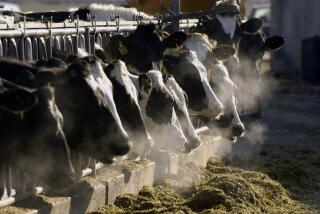Raw Milk Links to Illness Found
- Share via
Raw milk’s credibility as a consumer product may be undermined as the result of several health reports, news accounts and a recent court recommendation.
Some of the events involving the so-called health food that forgoes the pasteurization process include:
--A warning in the Western Journal of Medicine that “health care providers need to be alert to the potential of milk-borne disease, especially when raw milk or raw milk products are consumed.” The article in the November issue of the publication also stated that although 95% of all milk consumed in this country in pasteurized, more than 95% of all milk-borne outbreaks are due to raw milk.
--An unexplained 300% increase in the number of Salmonella newport cases diagnosed in Los Angeles County in the last several months, according to the county’s Public Health Letter. Since July 1, there have been 89 isolations of Salmonella newport reported locally compared with 23 during the same period last year. Health officials have not been able to identify the exact source of the most recent cluster of poisonings. However, this particular strain of the bacteria has been linked to raw milk consumption in the past.
Children Stricken
--A Northern California newspaper reported that 17 children who visited a Tracy, Calif., dairy last month became ill after drinking raw milk during a class trip. Several of those who reported illnesses were diagnosed as having camphylobacter, a harmful bacteria linked to raw milk that causes severe diarrhea and other stomach disorders.
--As a result of an investigation into the listeria epidemic that was caused by contaminated Jalisco cheese earlier this year, the Los Angeles County Grand Jury has recommended that the state consider banning sales of raw milk to the public.
Whatever impact the latest series of events may have on raw milk is likely to be felt at Alta-Dena Dairies, the state’s largest producer of certified raw milk. The City of Industry firm markets certified raw milk and raw milk products under its Stueve’s Natural line.
Alta-Dena was not singled out in any of the above incidents, and a company spokesman said there is a basic difference between the raw milk being discussed and certified raw milk.
Bacteria Growth
The certification process involves greater care in cleansing the cows before milking begins and then ensuring that the milk is kept cold throughout packaging and shipping. The process also requires regular health checks of both animals and employees for the presence of disease.
Boyd Clark, Alta-Dena’s general manager, hadn’t seen the report in the Western Journal of Medicine but said its author, James Chin, an epidemiologist with the state’s Department of Health Services, was biased.
“We know Dr. Chin is anti-raw milk and anti-Alta-Dena. . . . I don’t see how we’re involved in this at all. He’s talking about raw milk and we sell certified raw milk. There’s a big difference,” Clark said. “There’s just a basic philosophical difference between Chin and those consumers who want to purchase certified raw milk.”
Contamination concerns--The raw milk developments come at a time when consumers are apparently aware of food safety issues, according to a nationwide poll published earlier this year by the Food Marketing Institute, a grocers’ trade association.
The survey found that 73% of those queried considered the possibility of harmful residues in food to be a “serious health hazard.” Twenty-one percent believed that residues were “something of a hazard,” whereas 4% did not believe that residues presented a health threat and 2% were not sure, the food retailers’ group reported.
The poll defined residues as being either pesticides or herbicides and did not directly take up the issue of bacterial contamination.
Even so, the poll did include a question pertaining to the highly publicized food contamination issues of the last year, such as the salmonella outbreak in Illinois and the local listeria episode. Those surveyed were asked whether they “avoid buying certain foods because (they are) concerned about whether (the foods) are safe.” Forty-six percent said that statement was “very close” to their beliefs while 24% said the statement was “somewhat close.”
Defining a classic--Sometimes it’s just not possible to please everyone--at least that’s the message that Coca-Cola Co. executives must be mulling over these days. Bowing to intense consumer displeasure over the “new Coke,” the company reintroduced Classic Coke. Well, the return of the veteran formula was not well received in all quarters.
Coca-Cola devotees and historians note that this particular classic is not nearly the formula that made Coke America’s leading soft drink. These critics state that the real Coke was sweetened entirely with pure sugar whereas today’s version uses only corn syrup.
The Sugar Assn., a Washington-based sugar manufacturers group, claims the switch was originally made in 1980 when a blend of sugar and corn syrup was introduced. Then in 1984 Coke went to 100% corn syrup and this is the formula recently reintroduced as Classic Coke.
Corn syrup is slightly less expensive for manufacturers to use than sugar and by making the switch the giant beverage firm was able to save about a penny a bottle or can.
The Sugar Assn. is pressuring Coca-Cola to use sugar again and has launched a full-page newspaper advertising campaign to state its case. The ads advocate a return to the 100% sugar-sweetened beverage by stating that Coke’s share of the soft drink market has declined steadily since the introduction of corn syrup in the tangy, brown beverage. The group also criticizes the soft drink giant for failing to fully inform consumers of the switch from sugar to corn syrup.






